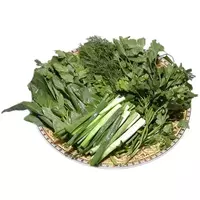Fresh greens

Both chefs, professionals and most modern hostesses actively use fresh greens in the process of preparing their culinary masterpieces. Greenery is called the upper young shoots of various plants or herbs. As a rule, greens are used fresh, since the dried product goes into the category of spices and spices. Most often in cooking, fresh greens are used as a decoration or supplement to already cooked dishes. In addition, soups are seasoned with fresh herbs, added to salads, as well as main dishes and side dishes.
We think many do not mind eating boiled new potatoes, seasoned with butter, as well as green onions, parsley or dill. By fresh greens in our latitudes, it is customary to mean such plants as dill, spring onions, as well as parsley. These plants are not only classified as fresh greens. For a long time, onions, parsley and dill have been ranked among the most widespread and often eaten seasonings. In addition, in the Russian national culinary tradition, cilantro and sorrel, celery leaves, as well as various types of green salads and garlic shoots are considered greens.
It is not difficult to notice that plants are ranked among the greens, which, as a rule, grow in the gardens and cottages of our compatriots. Fresh greens also play an important role in the cooking of European countries, as well as the CIS countries. For example, in Europe there is such a concept as soup greens.
This is a mixture of various root vegetables, such as carrots, celery roots or parsley, as well as rutabaga with onions, as well as so-called table greens. Based on the name, it is clear that soup greens are used to prepare the first courses. It is believed that the soup type of greens saturates the broth with an extraordinary taste and aroma.
Types of greenery
Currently, there are a huge number of types of greens that differ from each other not only in appearance and taste characteristics, as well as in distribution range and methods of application. Among the most common types of greens that have been used in Russian cuisine since ancient times, the following can be distinguished:
parsley greens;
dill greens;
cilantro greens;
spinach greens;
sorrel greens;
celery greens;
spring onions;
garlic shoots;
green salad;
melissa and mint.
Besides, the greens are represented by amateurs, fennel, basil, radish tops, turnips, beets, carrots. Some wild plants are also called greens, for example, raspberry leaves, shepherd's bag or wet. It is worth noting that the calorie content of greens depends primarily on the product wil. However, even the average calorie content of greens is at a very low level.
Composition of greens
The composition of the green contains an incredibly large number of useful and indispensable compounds for the human body. Due to the low calorie level, as well as the unique vitamin-mineral composition, greens can be considered not only useful, but also a dietary food. The benefits of greenery are worth considering in terms of each plant species. for example, the benefits of parsley greens are a high content of vitamin C (4 times more than in lemon).
Benefits of greenery
Dill greens are enriched with vitamins of the PP group, which is indispensable for the vessels and capillaries of the human body. Cilantro has a record content of amino acids in its composition, as well as vitamin B, C and carotene. Spinach is called the "champion" among greens due to its unique chemical composition. We assure you that any type of greens will become tasty, beautiful, and most importantly a useful addition for your dishes.
fresh greens 25.5 kCal
Energy value of fresh greens (Ratio of proteins, fats, carbohydrates - ju):
Proteins: 1.78 g (~ 7 kCal)
Fats: 0.55 g. (~ 5 kCal)
Carbohydrates: 4.15g (~ 17kCal)
Energy ratio (bj | y): 28% | 19% | 65%
 Español
Español Français
Français Português
Português Русский
Русский 简体中文
简体中文 繁體中文
繁體中文 日本語
日本語 한국어
한국어 العربية
العربية Türkçe
Türkçe Қазақ
Қазақ Deutsch
Deutsch Italiano
Italiano Українська
Українська
